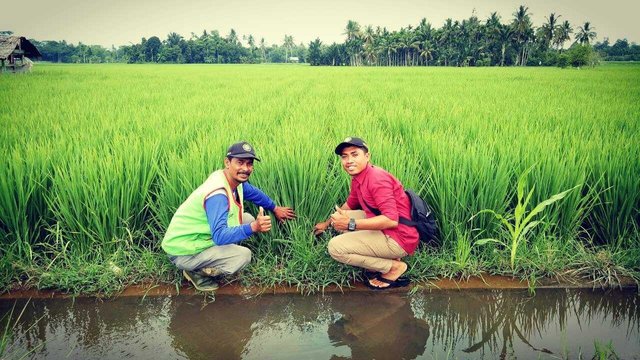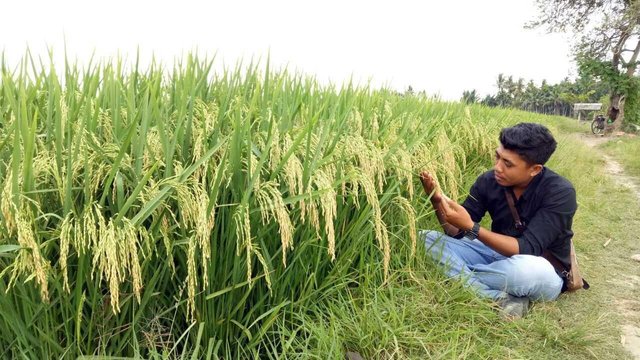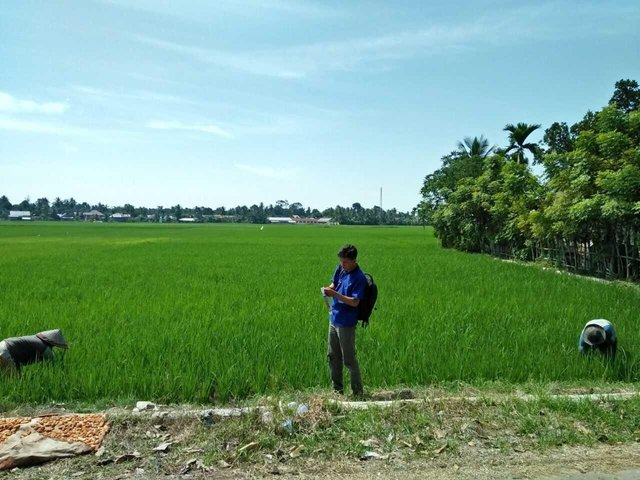the process occurs panai rice and post-harvest
The process of breeding rice crops. there are 2 phases. 1. vegetative phase and 2. generative. explanation this time in phase 2 that is the generative phase so The development of plants at this stage begins with the initiation of interest (panicle initiation). Malai tree looks white cone (white feathery cone) length 1.0-1,5 mm.

It first appears in the main book section (main culm) and then on the puppies with irregular patterns. This will develop until the panicle shapes are clearly visible so that the spikelets are visible and can be distinguished.

The young blade increases in size and develops upward inside the bark of the flag causing the bulge. This bundle of leaves is called bunting as the second stage of this phase (booting stage).

Phase Bunting (booting stage)
Bunting is first seen on the main stem segment. At the pregnant stage, the tip leaves wither (old and dead) and non-productive tillers are seen at the bottom of the plant.
Stage Exit Malai (heading stage)
The next stage of this phase is the stage out malai.Heading marked by the emergence of the tip of panai from the flag bark. Malai continues to grow until completely out of the leaf midrib.
The end of this phase is the flowering stage that begins when the pollen protrudes out of the grain and fertilization takes place.
Flowering stage (flowering stage)
In flowering, flower petals open, anther pokes out of flower glumes due to elongation of stamens and sheds. The flower petals then close. Pollen or pollen fall into the pistil, resulting in fertilization.
The hairy pistil structure in which the pollen tube of the emitted pollen (round, dark structure in this illustration) will expand into the ovary.
Flowering takes place a day after heading.In general, florets (flower petals) open in the morning. All spikelet on panicles open in 7 days. In flowering, 3-5 leaves are still active.
Saplings on these rice plants have been separated at the start of flowering and are grouped into productive and nonproductive tillers.
The reproductive phase that begins from flower initiation to flowering (after the stitch is fertilized by pollen) lasts about 35 days. Growing growth regulators or the addition of plant hormones (pythohormon) in the form of gibberlin (GA3) and plant maintenance from disease attack are essential in this phase.
The difference of the reproductive phase period between the early and early-year rice varieties is not significantly different. The availability of water in this phase is necessary, especially in the last stage expected to be inundated 5 - 7 cm.
![ithe process of breeding rice crops. there are 2 phases. 1. vegetative phase and 2. generative. explanation this time in phase 2 that is the generative phase so The development of plants at this stage begins with the initiation of interest (panicle initiation). Malai tree looks white cone (white feathery cone) length 1.0-1,5 mm.
It first appears in the main book section (main culm) and then on the puppies with irregular patterns. This will develop until the panicle shapes are clearly visible so that the spikelets are visible and can be distinguished.
The young blade increases in size and develops upward inside the bark of the flag causing the bulge. This bundle of leaves is called bunting as the second stage of this phase (booting stage).
Phase Bunting (booting stage)
Bunting is first seen on the main stem segment. At the pregnant stage, the tip leaves wither (old and dead) and non-productive tillers are seen at the bottom of the plant.
Stage Exit Malai (heading stage)
The next stage of this phase is the stage out malai.Heading marked by the emergence of the tip of panai from the flag bark. Malai continues to grow until completely out of the leaf midrib.
The end of this phase is the flowering stage that begins when the pollen protrudes out of the grain and fertilization takes place.
Flowering stage (flowering stage)
In flowering, flower petals open, anther pokes out of flower glumes due to elongation of stamens and sheds. The flower petals then close. Pollen or pollen fall into the pistil, resulting in fertilization.
The hairy pistil structure in which the pollen tube of the emitted pollen (round, dark structure in this illustration) will expand into the ovary.
Flowering takes place a day after heading.In general, florets (flower petals) open in the morning. All spikelet on panicles open in 7 days. In flowering, 3-5 leaves are still active.
Saplings on these rice plants have been separated at the start of flowering and are grouped into productive and nonproductive tillers.
The reproductive phase that begins from flower initiation to flowering (after the stitch is fertilized by pollen) lasts about 35 days. Growing growth regulators or the addition of plant hormones (pythohormon) in the form of gibberlin (GA3) and plant maintenance from disease attack are essential in this phase.
The difference of the reproductive phase period between the early and early-year rice varieties is not significantly different. The availability of water in this phase is necessary, especially in the last stage expected to be inundated 5 - 7 cm.
At this stage, the grain begins to fill with milk-like ingredients. Grain starts to fill with a milky white solution, can be removed by pressing / pinning the grain between two fingers. Green blinds and start ducking.
The senescence at the bottom of the tillers continues. The flag leaves and the two leaves underneath are green. This stage is most preferred by the pest. At the time of charging, the availability of water is also very necessary. As in the previous phase, this phase is expected to be inundated 5 - 7 cm.
Grain stage ½ mature (dough grain stage)
At this stage, the content of the milk-like grain turns into a soft lump and eventually hardened. The grain on the panicle starts to turn yellow. The senescence of the seedlings and leaves at the bottom of the plant appears to be increasingly clear. Crops look yellow. As the yellowing turns, the last two ends of each tiller begin to dry.
Full mature grain stages (Mature Grain Stage)
Each grain is ripe, fully grown, hard and yellow. Rice plants at the mature stage 90 - 100% of the grain content turns to yellow and hard. The top leaves dries quickly (leaves of some varieties are still green).
A number of dead leaves accumulate at the base of the plant. Unlike the initial stages of cooking, at this stage water is no longer needed, the soil is left in dry conditions. The maturation period, from the stage of ripe milk to full ripe grain or physiological cooking lasts for about 35 days.